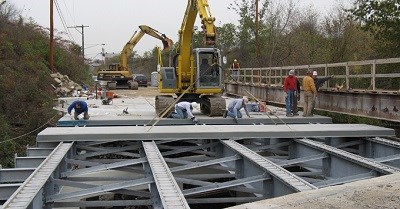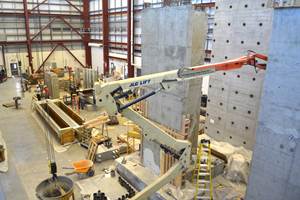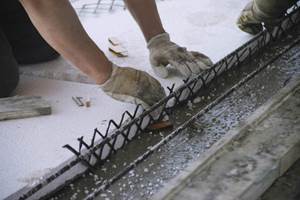How have composite bridges measured up?
The latest US highway bill includes a provision to assess performance of composite bridges built years ago, bridges that CW wrote about.

Composite Advantage has found commercial success with composite bridges, as shown here. Yet many bridges built with composites from 1998 to 2004 under the Federal Highway Administration's Innovative Bridge Research and Construction (IBRC) program will now be assessed.
ACMA (American Composites Manufacturers Association, Arlington, VA, US) recently highlighted a provision in the $305 billion highway bill that will direct the Federal Highway Administration (FHWA) to contract with the Transportation Research Board (TRB) to assess the overall performance of more than 300 bridges built under the Innovative Bridge Research and Construction (IBRC) program. The IBRC was a six year program started in 1998 that saw more than 150 bridge projects incorporate composites. While bridge monitoring continued through 2004, FHWA discontinued funding for performance tracking, but with the new bill provision, these bridges will get another look. The study will assess the performance of the bridges built under the IBRC and compare them to bridges built with traditional materials and technologies. The study will also provide recommendations to Congress on how the installed lifecycle costs of bridges could be reduced through the use of these innovative materials and technologies.
CompositesWorld and its predecessor magazines Composites Technology and High-Performance Composites published quite a number of articles about these bridge projects, which spanned the gamut of material and design approaches. I thought it might be interesting to go back and take a look at what technologies were used in a few key composite vehicular bridges, and I hope to gain access to the collected performance data to come, to report later on how they have fared since installation.
Mill Creek, DE, US bridge deck built by Hardcore Composites: In the September/October 1999 issue of Composites Technology, the Inside Manufacturing story focused on one of Hardcore’s first one-piece infused decks with integral wear surface. At 12m long, 5.2m wide and 0.25m deep with integral curbs and scuppers, the deck was fabricated via the SCRIMP infusion process. A polymer concrete wear surface was added to the top surface of the cured composite, and the deck was bolted to steel support girders. Installation was completed in one afternoon, and total deck weight was one-fifth the weight of a steel-reinforced concrete solution. Hardcore often used the multiaxial glass fabrics manufactured by Brunswick Technologies, called White Steel (Brunswick Technologies is now owned by Owens Corning).
Crawford County, KS, US bridge decks: In the March/April 2000 issue of Composites Technology, a survey of composite bridge installations included several in Kansas, whose department of transportation was willing to give composites a try. For Route K126 in Crawford County, two bridges with ample steel girder support were designed with thin, 120 mm-thick decks made by Kansas Structural Composites Inc. (KSCI, Russell, KS, US). KSCI’s design used a composite, large-cell honeycomb core made with chopped strand mat, combined with glass face skins made with Brunswick Technologies stitched glass fabric. The core was similar to that seen in cardboard boxes: sinusoidal webs alternate with straight webs in the core. L-shaped clamps were used to attach the multiple deck panels, made with a polymer concrete wear surface, to the underlying girders. Each deck took one only day to install, and met the AASHTO load rating designated by the state. An interesting side story is that CW contacted Kansas in 2003 regarding the two bridges, and learned that one had suffered damage from repeated punch loads, due to an improper approach profile at one end; cars tended to “launch” and then impact the first panel. The Kansas DOT spokesman reported that a repair to the faceskin laminate was easily completed, by cutting out the damage and bonding a new face to the core. (Vandals also tried shooting the deck with rifles, but the bullets didn’t penetrate the faceskins.)
Ohio and California — Duraspan decks: In the early 2000s, Martin Marietta Composites (MMC, Raleigh, NC, US), which ceased making products in 2010, was marketing its Duraspan bridge deck, a pultruded design with trapezoidal inner core tubes. Working with pultruders Glasforms Inc. (San Jose, CA, US) and later Creative Pultrusions Inc. (Alum Bank, PA, US), MMC produced decks for several projects, including one funded in part by the Defense Advanced Research Projects Agency (DARPA) in Ansonia, OH along Route 47, described in the March/April 2000 issue of Composites Technology. The Ansonia bridge deck comprised six pultruded panels, each 2.4m wide and 14.1m long, on steel girders. Panels were bonded together with an epoxy adhesive, then the joint was sealed with three layers of triaxial fabric supplied by VectorPly Corp. (then called Johnston Composite Reinforcements, Phenix City, AL, US). The panels were attached to the girders with Nelson studs, which are lengths of vertical steel rebar welded to the top of the girder; the studs fit inside holes drilled in the underside of the deck panels. Holes were filled with concrete grout.
Schuyler Heim lift gate bridge, Long Beach, CA, US: Another notable Duraspan deck replaced steel grating on the Schuyler Heim lift bridge in Long Beach, CA, US, which we wrote about in the July/August 2001 issue of High-Performance Composites. Also an MMC project, the deck combined glass and carbon fiber to achieve adequate stiffness and meet deflection targets in a thin profile that had to match that of the steel grating: 125 mm or 5 inches. Using carbon also helped the deck more closely match the coefficient of thermal expansion (CTE) of the underlying support girders. The deck combined beefy faceskins of uni carbon, carbon fabrics, glass fabrics and glass mat over pultruded square core tubes made by Strongwell (Bristol, VA, US). The deck design underwent a finite element analysis and virtual performance testing before being built, and was extensively tested and monitoredby university researchers prior to and after installation. The lift bridge is currently being replaced with a fixed-span bridge, but the highly-instrumented, composite drop-in replacement deck got plenty of press in numerous technical papers and textbooks.
Waupun, WI, US, twin bridges on Rt. 151: This “hybrid” bridge undertaken by the Wisconsin Dept. of Transportation and the Federal Highway Amin. (FHWA) under the IBRC consisted of combining composites with more traditional concrete construction methods, an experiment to see if DOTs might accept a less, full-on composites approach. We featured this bridge in the February 2004 issue of Composites Technology. Prestressed concrete girders were covered with pultruded composite deck panels made by Diversified Structural Composites (Erlanger, KY, US), then composite rebar from Hughes Bros. Inc. (Seward, NE, US) was placed together with a bidirectional pultruded fiberglass bar grid from Strongwell on top of the panels. The panels formed the lower tensile reinforcement for the bridge deck, and were covered with a coarse limestone aggregate adhered with an epoxy paste. The entire panel/rebar/grid assembly was then covered in standard concrete to form the bridge deck. Here’s the cool thing: because there were two identical bridge crossings, one used the composite hybrid design described above, while the other was made the old-fashioned way with steel rebar and typical concrete forming. BOM cost for the traditional steel bridge was $419,566, and the composite-enhanced version cost $632,718. Both were extensively instrumented with strain gauges and monitored after installation. The traditional bridge consumed 585 man-hours, but the composite/concrete bridge only took 206 man-hours, mostly because the Strongwell bar grid created a level surface for workers to walk on, and the pour could be accomplished much more quickly. CW’s story conclusion was that the composite design’s faster and more efficient installation, without the need for heavy cranes or equipment, could offset the upfront material cost.
Will composites ever displace steel-reinforced concrete in bridges? Probably not, and one might assume that these experimental composite material solutions were just too new, different or expensive to be widely adopted, especially in the U.S. And there were issues with some IBRC program bridges, perhaps the most notable of which was the Salem Ave. bridge in Dayton, OH, US. In that installation, four different composite deck types from four different manufacturers were installed on one of two spans, and at the time (1999) it was the largest composite bridge deck in the world. Each panel type (explained in CW’s December 2003 article, here: http://www.compositesworld.com/articles/how-are-composite-bridges-performing) was attached to underlying steel girders with studs welded to the top of the girders; holes in the deck panels accepted the studs (holes were filled with grout). A lot of monitoring and lab testing ensued, and researchers found that the four panel types, being of dissimilar design, moved and behaved differently under load, and in some cases, lost firm connection to the underlying support girders. Yet at the time of the article, the Ohio DOT representative still saw the project as a success, given the “lessons learned” data it yielded.
Still, composite bridges are an application dream not easily given up, and there is hope for wider application as designs evolve and become more cost-effective. Composite Advantage LLC (Dayton, OH, US), a spinoff from the National Composite Center (NCC), has a successful business focusing on pedestrian bridge projects as well as large-scale vehicular bridges and marine structures. Another is FiberCore Europe (Rotterdam, The Netherlands), with an extensive portfolio of bridges large and small. And don’t forget the University of Maine’s bridge-in-a-backpack concept (http://www.compositesworld.com/articles/bridge-cost-cut-with-inflatable-arches) , which won a White House Champions of Change Program award in 2015 and has been used to construct at least 18 bridges to date. Let’s hope the current evaluation program will point DOTs in the composite direction.
Related Content
KU researchers explore FRP materials for dams, levee reinforcement
To address aging infrastructure, a team of researchers at KU is conducting research into repairing and retrofitting 700-plus dams, levees and related structures nationwide using FRP materials.
Read MoreComposites-reinforced concrete for sustainable data center construction
Metromont’s C-GRID-reinforced insulated precast concrete’s high strength, durability, light weight and ease of installation improve data center performance, construction time and sustainability.
Read MoreComposites reinvent infrastructure
Celebrating National Composites Week, CW shares ways in which composites continue to evolve the way we approach infrastructure projects.
Read MoreCirculinQ: Glass fiber, recycled plastic turn paving into climate solutions
Durable, modular paving system from recycled composite filters, collects, infiltrates stormwater to reduce flooding and recharge local aquifers.
Read MoreRead Next
All-recycled, needle-punched nonwoven CFRP slashes carbon footprint of Formula 2 seat
Dallara and Tenowo collaborate to produce a race-ready Formula 2 seat using recycled carbon fiber, reducing CO2 emissions by 97.5% compared to virgin materials.
Read MoreVIDEO: High-volume processing for fiberglass components
Cannon Ergos, a company specializing in high-ton presses and equipment for composites fabrication and plastics processing, displayed automotive and industrial components at CAMX 2024.
Read MorePlant tour: Daher Shap’in TechCenter and composites production plant, Saint-Aignan-de-Grandlieu, France
Co-located R&D and production advance OOA thermosets, thermoplastics, welding, recycling and digital technologies for faster processing and certification of lighter, more sustainable composites.
Read More






















